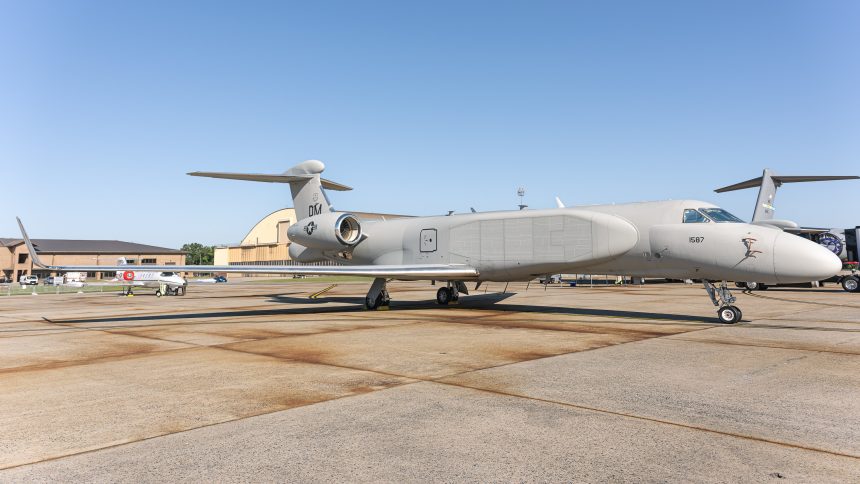While the aerobatic acts thrilled the crowd at the recent Joint Base Andrews Air Show, an EA-37B Compass Call on static display, quietly revealed the power of modern electronic warfare.
Tens of thousands air show fans at Joint Base Andrews in Maryland gazed upward toward the sky, in search of loops, aileron rolls, and afterburning engines, however one of the show’s most significant aircraft never left the ground. Parked quietly on the tarmac, the EA-37B Compass Call—an electronic warfare aircraft few civilians ever see up close—drew a different kind of attention.
Unlike the thunderous fighters overhead, its power lies in silence, disrupting enemy communications and command networks far from the public eye. For one young Air Force Captain standing beside it, the static display was less about spectacle and more about offering a rare glimpse into the hidden side of modern air combat.
The EA-37B is the Air Force’s newest generation of electronic warfare aircraft, built to disrupt enemy command and control networks. Instead of firing missiles or dropping bombs, it disables adversaries by jamming communications, radar, and signals that keep hostile forces connected. In conflicts where speed of information often dictates victory, the Compass Call’s invisible strikes can be as decisive as any fighter jet overhead.
This latest Compass Call replaces the venerable EC-130H, a heavily modified Lockheed C-130 Hercules airframe that served for decades. Transitioning to the Gulfstream G550 airframe has transformed the mission platform, as the EA-37B is faster, more efficient, and capable of operating at higher altitudes, extending its range and effectiveness. Along with upgraded electronic systems, the aircraft is tailored for modern threats in the digital battlespace.
EA-37B 19-5591 as ” FLITE09 ” returns to KCNW Waco with a gentle sunset glow. pic.twitter.com/F0rA1yn96W
— 𝗦𝗥_𝗣𝗹𝗮𝗻𝗲𝘀𝗽𝗼𝘁𝘁𝗲𝗿 (@SR_Planespotter) June 24, 2024
Rarely seen by the public, the EA-37B’s appearance at the Andrews open house was unusual in itself — in fact, this marked only the third time the aircraft has been placed on static display. Unlike a Thunderbird F-16, the Compass Call doesn’t captivate with speed or precision flying. Its significance lies in what it prevents, not what it performs. In a show defined by spectacle, this aircraft reminded visitors that the most important missions can often happen far from view.
The aircraft’s quiet presence at Andrews AFB was symbolic, what it lacks in aerial parade, it compensates for with a complex electronic arsenal. To understand its role, one must step inside the EA-37B’s architecture and examine the systems that give it strategic heft.
Inside the EA-37B Compass Call
The EA-37B Compass Call is best understood as a flying, reconfigurable electronic effects center, designed to detect, analyze, and then disrupt or deny the electromagnetic spectrum adversaries rely on for command and coordination. Built on a business-jet platform for speed, endurance, and efficiency, the EA-37B leverages software-defined systems to deliver adaptable dominance across the radio frequency spectrum.
At the physical layer, the Gulfstream G550 airframe provides the structural and environmental host. The airplane’s sleek fuselage carries multiple conformal antenna arrays, (low-profile antenna panels attached to the skin of the jet), in addition, there are a series of distributed dorsal, ventral, tail, and side-mounted elements. This architecture provides the ability to create and steer multiple receive and transmit beams without mechanical gimbals. Thus, improving beam performance while keeping drag and radar signature lower than legacy podded solutions.
Beneath the antennas sit the software defined radios (SDRs). They act as the digital receivers and transmitters of the EA-37B. SDRs can be reprogrammed for new frequency bands, waveforms, and partition resources dynamically between sensing and jamming tasks.
The radios are pooled into the aircraft’s SABER (Small Adaptive Bank of Electronic Resources) system, a modular set of receivers, digitizers, and signal processing pipelines that ingest wideband RF, detect transmissions, perform modulation and protocol analysis, and produce geolocation and emitter-classification data in near real time. SABER is the platform’s sensor layer: its job is to answer “who is transmitting, what are they using, and where are they located?”
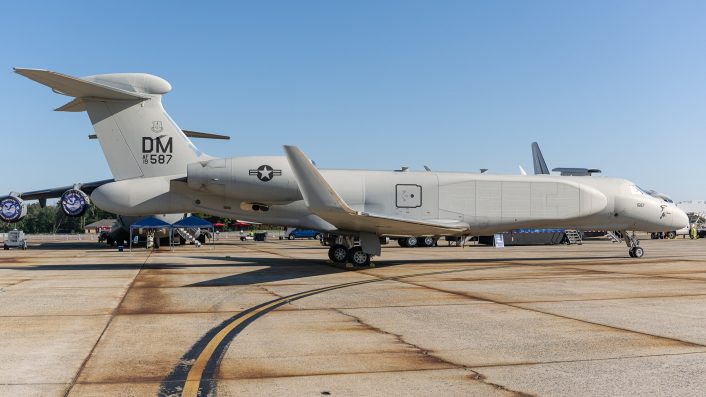
Above SABER sits SWORD (System Wide Open Reconfigurable Dynamic Architecture). Where SABER builds the picture, SWORD decides the action. SWORD is the EA-37B’s architecture and orchestration layer, the “brain and highway” that sits above the resource bank and tells the radios, amplifiers, and antennas how to act.
Because it’s “system-wide” and “open/reconfigurable,” SWORD is designed to treat subsystems as modular services, it schedules and assigns SDR channels and amplifier time, picks or composes waveforms from libraries, enforces rules of engagement and deconfliction policies, and coordinates effects across on-board assets and external platforms via datalinks. The “open” and “reconfigurable” design lets new algorithms, waveforms, or third-party modules be added without ripping out hardware, a crucial attribute in a rapidly evolving RF threat environment.
The transmit chain converts SWORD’s decisions into electromagnetic effects by directing concentrated jamming or deceptive signals at specific emitters.
Within the platform, human operators remain in the loop. Operator consoles show SABER’s spectral maps and geolocation data alongside SWORD’s recommended courses of action; crews can accept automated recommendations, refine parameters, or override actions to manage legal and tactical risk. Meanwhile, secure datalinks allow the EA-37B to share emitter data and coordinate effects with other aircraft, ground cells, or command nodes, making Compass Call an integrated node in a broader, multi-platform EW campaign.
In summary, the system operates in a sense, decide, act, assess loop. SABER senses and classifies an emitter, SWORD selects resources and composes a response, the platform then projects electronically steered jamming and deception. SABER and linked ISR (Intelligence, Surveillance and Reconnaissance) assets immediately measure the effect so SWORD can adapt. The result is a small, highly reconfigurable fleet optimized for rapid adaptation in contested electromagnetic environments.
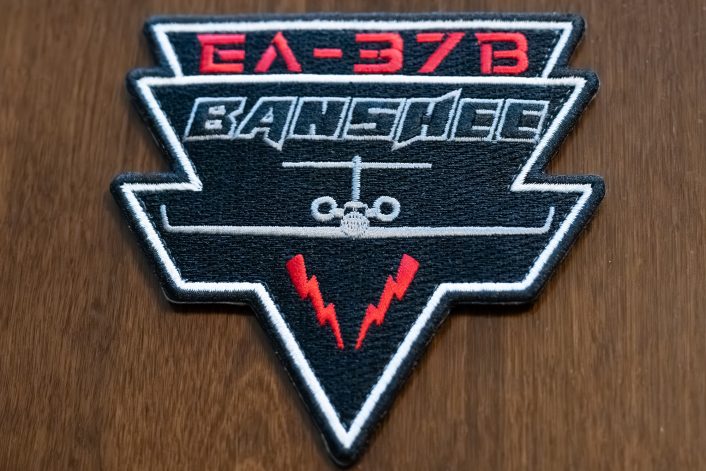
EA-37B Fleet Size
While we were declined details on the size of the EA-37B fleet, public records offer a clearer picture. According to the Fiscal Year 2025 National Defense Authorization Act and related budget documents, the Air Force’s program of record calls for a total of ten Compass Call aircraft.
Five have been delivered as of early 2025, with the remaining five scheduled for handover by 2027. Although contractors BAE Systems and L3Harris have advocated expanding the buy, including a proposal to add two more aircraft to the FY2026 unfunded priorities list, the FY2025 NDAA did not act on that request.
Interview with Captain Mike Williams
Standing beside the Compass Call on the tarmac, dressed in his flight suit and patiently fielding questions from curious visitors, the young 1st Lieutenant (now, newly pinned Captain) was both approachable and proud of the mission he represents. Though careful not to reveal classified details, he spoke candidly about the unique demands of flying the EA-37B and what it means to serve as part of a crew entrusted with such a specialized role. Our conversation offered a glimpse into the human side of a platform most people only read about in brief defense headlines.
Captain Mike Williams is an EA-37B pilot assigned to the 43rd Electronic Combat Squadron (ECS), a tenant unit at Davis–Monthan Air Force Base, Arizona. The 43rd ECS falls under the 55th Electronic Combat Group, also based at Davis–Monthan, which is part of the 55th Wing, headquartered at Offutt Air Force Base, Nebraska.
The Aviationist: Can you please provide us your background, where you grew up, where you went to school, and your route to being a pilot, flying the EA-37B?
Thanks, I am Captain Mike Williams of the 43rd Electronic Combat Squadron. I grew up in Ellicott City, Maryland, and earned a bachelor’s degree in mechanical engineering from Penn State University. While there, I completed four years in Air Force ROTC and commissioned in May 2021. During my junior year, I received a pilot slot and began preparing for Undergraduate Pilot Training at Columbus AFB, Mississippi.
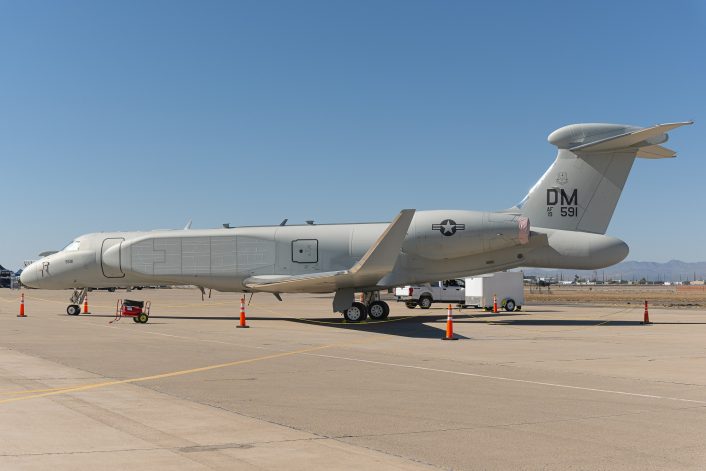
I started Initial Flight Training in Pueblo, Colorado, in February 2022, then transitioned to the T-6 Texan II in July 2022. I earned my wings in April 2023, completed the T-1 Jayhawk program in August 2023, and was selected for one of the final EC-130H assignments before the Air Force ended pilot inflow to that platform.
I flew the EC-130H for about 18 months before transitioning to the EA-37B. In May 2025, I trained on the civilian G550 and completed my EA-37B check ride in July 2025. The path has been challenging but rewarding, and I’m proud to now fly the Air Force’s newest combat aircraft—one designed to ensure U.S. dominance in the electromagnetic spectrum.
Q: Please provide operational aircraft flown, total number of hours in each, and total number of hours overall.
Operationally, outside of pilot training for the Air Force, I have flown the EC-130H for about 300 hours and, so far, have about 50 hours in the EA-37B.
Q: Can you please explain the broad mission role of the EA-37B?
The EA-37B is an electronic-attack aircraft that denies, degrades, and disrupts enemy command-and-control networks. Lt. Col. Heimburger (Author Note: 55th ECG integration office program director), offered a useful analogy: in a football game the offensive coordinator watches the whole field from the box and sends plays down to the quarterback, who then directs the offense.
Our job is to break that chain of communication—sever the link between the coordinator and the quarterback—so the opposing team cannot adapt. When we disrupt those signals, the adversary loses situational awareness and tempo, and friendly forces gain freedom of maneuver. By dominating the electromagnetic spectrum, the EA-37B shapes the battlespace and gives commanders a decisive advantage.
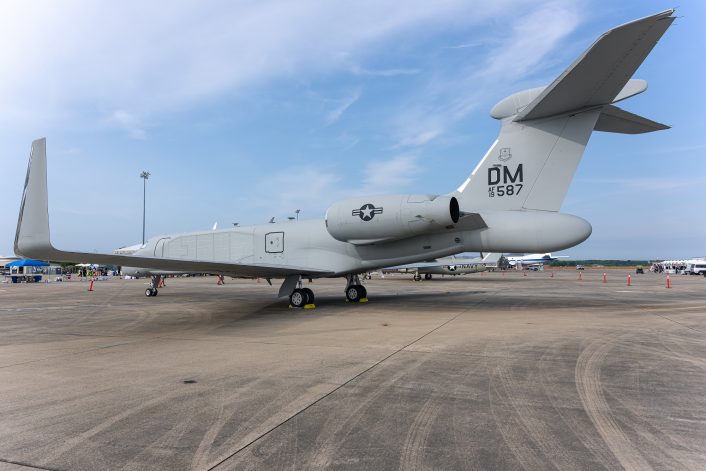
Q: It is quite rare to see the EA-37B on static display. How many air shows has the EA-37B attended?
We were at our home-based show at Davis-Monthan AFB, earlier in the year, the Langley AFB show back in April, and of course here at the Andrews AFB show.
Q: How does the EA-37B differ in feel or experience compared to the EC-130H?
The EC-130H served with distinction for decades and built a proud legacy as the Air Force’s airborne electromagnetic attack workhorse. However, the platform was aging and limited in speed, reach, and reliability.
The EA-37B represents a generational leap forward. With advanced automation, improved reliability, and powerful Rolls-Royce/BMW turbofan engines, it offers a broader range, faster speed, and greater mission endurance. The Gulfstream airframe also enhances pilot and crew comfort, allowing us to remain sharp during long missions. In short, the EA-37B builds on the Herk’s legacy but delivers the combat credibility we need for future conflicts.
Q: What does a “day in the life” look like for an EA-37B pilot, when not deployed?
Flying the EA-37B requires constant preparation and focus. Planning begins the day prior, with mission and flight planning sessions. On flight day, the crew briefs for several hours, executes the mission, and then conducts a detailed debrief.
Most of our sorties focus on training—pushing the aircraft into environments and airfields the EC-130H could never reach. Each mission sharpens our ability to adapt, integrates lessons learned, and builds readiness for the global environments where we may be called to fight. Every flight is a step toward ensuring the EA-37B is fully mission-ready for the joint force.
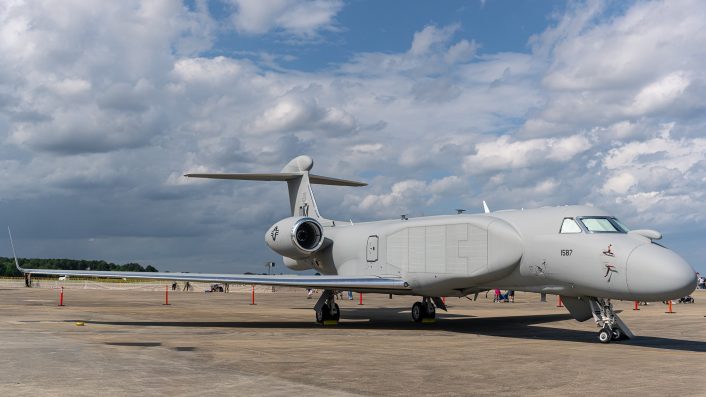
Q: Please describe the crew dynamic inside the aircraft – how do pilots and mission crew work together?
The EA-37B crew represents some of the most skilled Airmen in the Air Force. With a leaner crew than the EC-130H, every member carries greater responsibility, which demands precision teamwork and constant communication. Pilots are deeply integrated in mission planning and execution, coordinating airspace, contingencies, and mission system requirements.
In the cockpit, we manage navigation, communications, and aircraft control while providing mission crew with timely, relevant updates. This seamless flow of information allows our Airmen—each highly trained and hand-selected for this mission set—to execute as one cohesive, combat-credible team.
Q: How many pilots and crew members make-up a typical mission configuration for an EA-37B?
While I cannot discuss specific crew numbers, I can say that the men and women who make up the EA-37B crew are among the very best the Air Force has to offer. Every member is highly trained, hand-selected, and constantly sharpening their skills to ensure we can expertly operate the Department of the Air Force’s newest combat platform. Our crews represent the cutting edge of airborne electronic attack and stand ready to deliver effects whenever and wherever the nation calls.
Q: What environments do you train for?
We train for a wide range of mission sets and operational environments. Many of our operators gained combat experience in the Middle East, and that knowledge helps guide our approach today.
As a new platform, the EA-37B community is deliberately expanding its training scope—building general employment proficiency while developing advanced tactics. This ensures we can rapidly adapt and succeed in any theater where electronic attack is required.
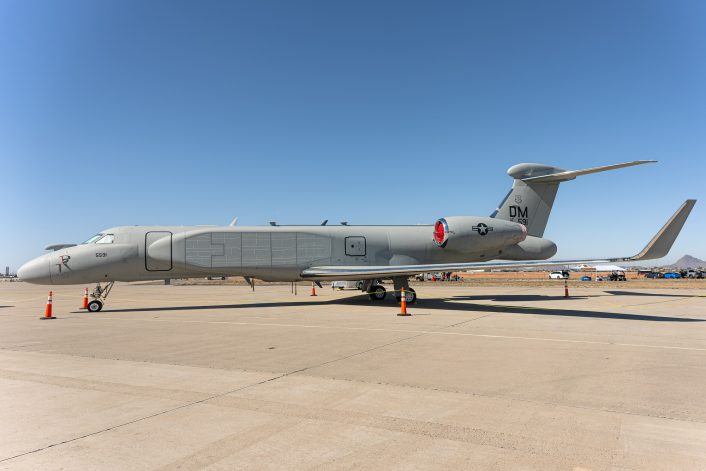
Q: How do pilots and mission crew prepare to integrate with other aircraft?
The EA-37B community emphasizes integration with joint and coalition partners. With the EC-130H, we trained extensively in Large Force Exercises, operating in high-tempo, contested environments. Those experiences built the foundation for how we now integrate the EA-37B.
We are beginning to bring the new aircraft into similar exercises, validating tactics, techniques, and procedures alongside other combat platforms. The goal is clear: to ensure seamless integration into the joint fight and to provide an unmatched electronic attack capability to commanders.
Q: How does the EA-37 fit into the bigger Air Force and joint mission picture?
The EA-37B fills a critical niche for the joint force: electronic attack in the modern battlespace. Warfare increasingly depends on digital and networked systems. By denying an adversary freedom in the electromagnetic spectrum, the EA-37B ensures U.S. and allied forces retain the initiative.
In short, this platform strengthens joint operations, safeguards our ability to maneuver, and reinforces American dominance across the spectrum of conflict.
Q: Lastly, what has been the biggest challenge in transitioning to this new platform?
Transitioning from the EC-130H to the EA-37B has been demanding but invigorating. The cockpit no longer includes navigators or flight engineers, so pilots assume those responsibilities. That change requires sharper skills and tighter coordination across a smaller crew.
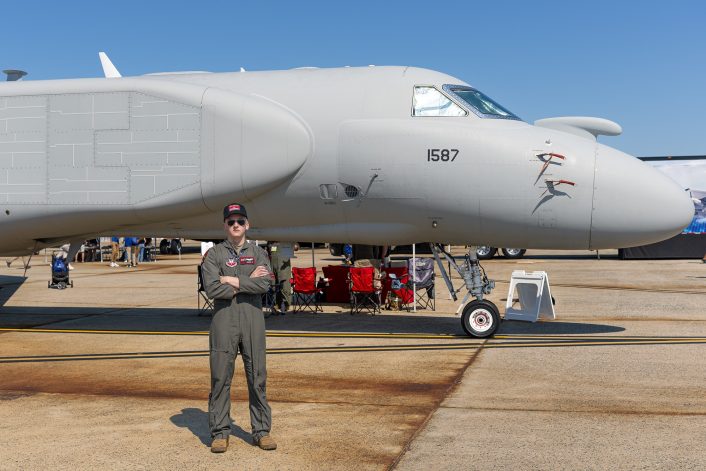
The Airmen selected for this mission are elite—trained to absorb added responsibilities and operate at the highest levels. While the adjustment has reshaped how we manage crew resource management, it has also streamlined decision-making and made us more agile. Today, we are forging a rhythm as one of the most capable, combat-credible teams in the Air Force, ready to bring the EA-37B’s unmatched capabilities into contested battlespaces.
Reflections
Captain Williams’ comments outlined the broader transition underway across the Compass Call community, as crews adapt from the EC-130H to a faster, more automated platform with a smaller team. That shift highlights the Air Force’s focus on efficiency and agility in preparing for operations in contested electromagnetic environments.
When the airshow concluded, the EA-37B remained on static display—a platform built for missions that rarely seek attention. Its role at the Andrews Open House was to inform and engage, but its operational purpose is to safeguard the networks, aircraft, and personnel that depend on dominance in the spectrum.
Acknowledgements
The author wishes to thank Lt. Col. Kais Heimburger, 43rd ECS, Captain Mike Williams, 43rd ECS, and Matt Ebarb, Chief Media Operations, 316th Wing Public Affairs, Joint Base Andrews, MD, for their time and patience in answering all questions.

